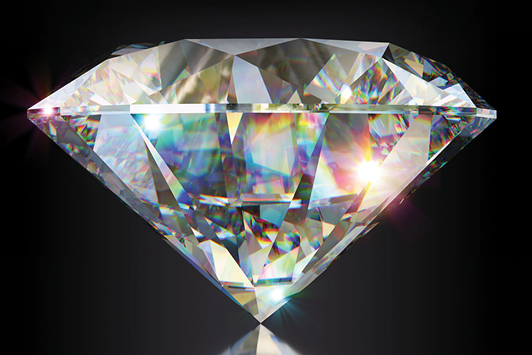
The glitter of a cut diamond can provoke wonder,
fascination, pride, love and a host of other reactions. But the scientific
reasons for that brilliance are as scintillating as the rock itself.
Carbon is the fourth most common element in the universe,
but only the tiniest fraction of those atoms have passed through the processes
needed to lock them into the crystal fortress we call a diamond. Once they’re
in place, the structure is the crystal equivalent of the Eiffel Tower — a
lightweight arrangement given strength by diagonal trusses, all built from a
single type of atom. And while this lattice gives diamond many striking
properties – for example, it’s got the highest hardness and thermal
conductivity of any natural material — the true spectacle occurs when you shine
light on it.
The speed of light is one of the fundamental constants of
physics, well known as the fastest speed that anything can travel. But none of
us has ever seen light traveling at the speed of light, because as soon as it
passes through something, it slows down just a bit. Even the air in our
atmosphere slows down sunlight by about 0.03%. Water slows it down by 25%, and
glass by 33%.
This is actually the only reason we can see glass at all —
when a light beam crosses the line between air and glass, it swerves, and the
larger the speed change, the greater the swerve. When we look at a wine glass,
we don’t “see” the glass at all. What we see is that light from behind the
glass is in the wrong place — it’s been deflected by the glass, so it doesn’t
match its surroundings. Instead of assuming that the world has gone wrong
somehow, our brains know to interpret this as a transparent solid material
that’s distorting reality.
It’s through this distortion of visual reality that a
diamond gets its shine. The stone’s crystal lattice can slow down light by a
staggering 59%, leaving it at only 41% of its full speed. Of course, the exact
percentage depends on the light’s color — it’s 41.6% of full speed for red and
40.6% for violet. When light hits a diamond facet, the resulting swerve splits
the light into colors and deflects it so strongly that it can bounce off the
far side of the diamond before making its way back out to our eye, broadcasting
the twinkling rainbow that characterizes these stones.
Almost nothing else can slow light this much — the only
rivals are a handful of manufactured crystals. Diamond is nature’s superstar
when it comes to corralling light.
The real beauty of diamond, then, is its exceptional ability
to take mundane white light from our surroundings, bend it, split it, and
deliver it back to us with a deeper side of its character on show. The richness
of the world is there all the time, but it takes a diamond to reveal its star
quality.
Helen Czerski is a physicist and oceanographer. She is
currently a research fellow in the department of mechanical engineering at
University College London, UK.
Image: ShutterstockArticle from the Rapaport Magazine - August 2017. To subscribe click here.